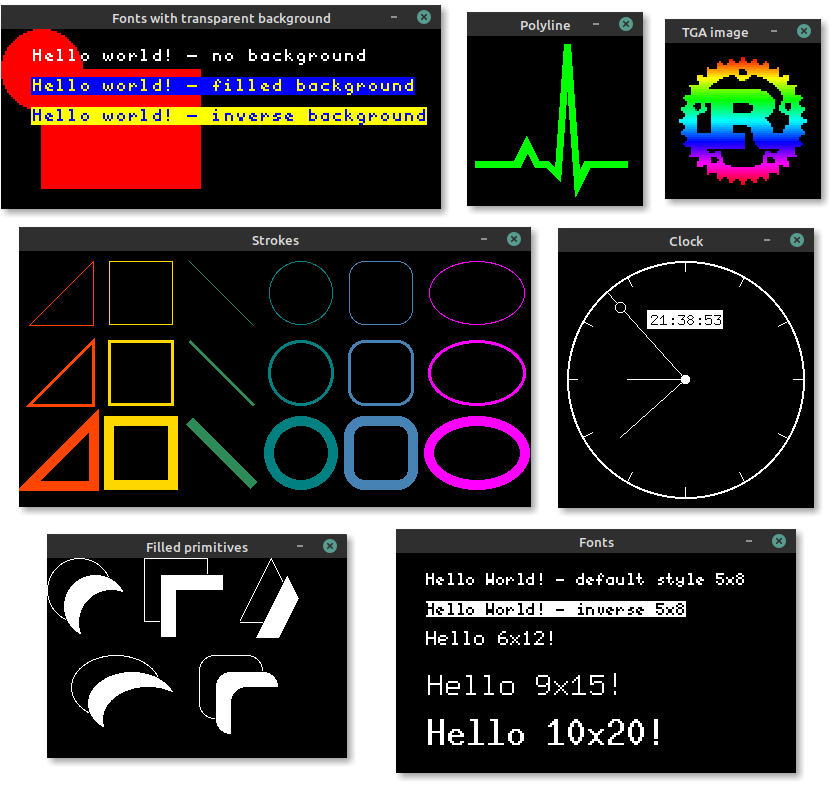Embedded graphics

Getting help/reporting an issue
If you think you've found a bug, or would like to suggest a new feature to add to embedded-graphics, please open an issue.
If you need more deeper/more personalised help, please check out the embedded-graphics Matrix channel.
Documentation
A small 2D graphics library to draw things on embedded graphical LCDs, like the SSD1306 OLED display.
This crate aims to make drawing 2D graphics primitives super easy. It currently supports the following:
- 1 bit-per-pixel images
- 8 bit-per-pixel images
- 16 bit-per-pixel images
- BMP format (
.bmp) images at 1, 8 or 16BPP (requiresbmpfeature) - TGA format (
.tga) images (requirestgafeature) - Primitives
- Lines
- Rectangles (and squares)
- Circles
- Triangles
- Text with multiple bitmap fonts
A core goal is to do the above without using any buffers; the crate should work without a
dynamic memory allocator and without pre-allocating large chunks of memory. To achieve this, it
takes an Iterator based approach, where pixel values and positions are calculated on the fly,
with the minimum of saved state. This allows the consuming application to use far less RAM at
little to no performance penalty.
More information and up to date docs can be found on docs.rs.
Example usage can be found in the simulator:
use ;
use Rgb565;
use *;
use ;
use ;
// Only used for examples - this would be replaced by the driver for your chosen display
use MockDisplay as Display;
Macros are also supported for text and primitives:
use Font6x8;
use Rgb565;
use *;
use ;
// Only used for examples - this would be replaced by the driver for your chosen display
use MockDisplay as Display;
Cargo Features
nalgebra_support- use the Nalgebra crate withno_stdsupport to enable conversions fromnalgebra::Vector2toCoordandUnsignedCoord.bmp- use the TinyBMP crate for BMP image support.tga- use the TinyTGA crate for TGA image support.
Display drivers with embedded-graphics support
- ili9341: A platform agnostic driver to interface with the ILI9341 (and ILI9340C) TFT LCD display
- ls010b7dh01: A platform agnostic driver for the LS010B7DH01 memory LCD display
- sh1106: I2C driver for the SH1106 OLED display
- ssd1306: I2C and SPI (4 wire) driver for the SSD1306 OLED display
- ssd1322: Pure Rust driver for the SSD1322 OLED display chip
- ssd1331: SPI (4 wire) driver for the SSD1331 OLED display
- ssd1351: SSD1351 driver
- ssd1675: Rust driver for the Solomon Systech SSD1675 e-Paper display (EPD) controller
- st7735-lcd: Rust library for displays using the ST7735 driver
- st7920: ST7920 LCD driver in Rust
There may be other drivers out there we don't know about yet. If you know of a driver to add to this list, please open an issue!
Development setup
Minimum supported Rust version
The minimum supported Rust version for embedded-graphics is 1.40.0 or greater.
Ensure you have the latest stable version of Rust installed, preferably through https://rustup.rs.
Ubuntu/Linux Mint
# Update to latest stable version of Rust
# Ensure rustfmt is installed
# Install SDL2 for simulator and PIP to install linkchecker
# Install linkchecker so doc links can be checked
Attribution
All source font PNGs are taken from the excellent Uzebox Wiki page.
License
Licensed under either of
- Apache License, Version 2.0 (LICENSE-APACHE or http://www.apache.org/licenses/LICENSE-2.0)
- MIT license (LICENSE-MIT or http://opensource.org/licenses/MIT)
at your option.
Contribution
Unless you explicitly state otherwise, any contribution intentionally submitted for inclusion in the work by you, as defined in the Apache-2.0 license, shall be dual licensed as above, without any additional terms or conditions.

